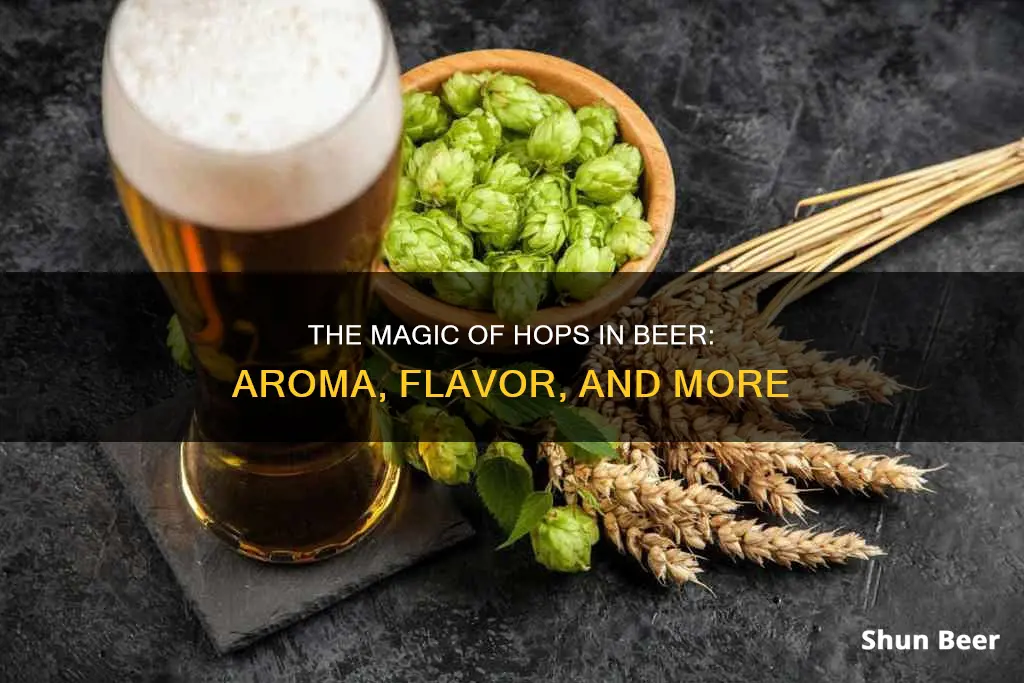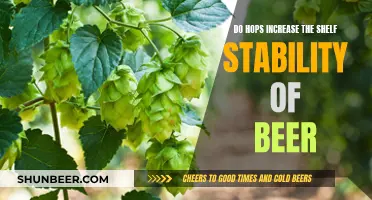
Hops are one of the key ingredients in beer, alongside water, barley (malt) and yeast. They are the flowers of the Humulus lupulus plant, which is a cousin of the cannabis plant. Hops are responsible for the bitterness, flavour and aroma of beer. They also act as a natural preservative, extending the shelf life of the beer. The brewing process involves boiling the hops, which breaks down the aromatic oils to create the signature bitter flavours. The hops are then added throughout the boil at different segments, with the later they are added, the more their aromatics are emphasised and the less bitterness they impart.
What You'll Learn

Hops add bitterness to beer
Hops are an essential ingredient in beer, adding bitterness, flavour, and aroma. The hop plant, Humulus lupulus, produces hanging flowers that contain lupulin, a substance that is largely responsible for the bitter taste of beer. These flowers are dried and processed into a concentrated form, which brewers use to extract the desired amount of bitterness.
The lupulin in hops contains resins and essential oils that contribute to the bitterness, aroma, and flavour of beer. When hops are boiled during the brewing process, they create soluble alpha and beta acids that become part of the brew, resulting in a bitter taste. The longer the hops boil, the more alpha acids are released, increasing the bitterness of the beer.
Brewers can adjust the bitterness of their beer by adding hops at different stages of the brewing process. Bittering hops are added early in the process to impart a strong bitterness, while aroma hops are added towards the end to emphasise their aromatic qualities and reduce the bitterness they impart.
The type of hops used also affects the bitterness of the beer. Old World hops, cultivated in Europe for centuries, are known for their subtle bitterness and aromatic qualities. On the other hand, New World hops, grown more recently in the Americas, have more intense and varied flavours, often compared to strong citrus fruits.
The bitterness of beer is measured in International Bittering Units (IBU). Some beers can be so bitter that they exceed 100 IBUs, the maximum amount of bitterness detectable by the human palate. However, the desired level of bitterness varies depending on the style of beer and the preferences of the brewer and drinker.
Herbs and Spices in Beer Before Hops
You may want to see also

They also add flavour and aroma
Hops are cone-shaped flowers of the Humulus lupulus plant, which is a cousin of the cannabis plant. They are packed with oils and flavours. The unique blend of oils present in each variety of hops contributes to the overall flavour of the beer.
The flavour comes from the resins and oils inside the lupulin glands of the hop cones. Lupulin is a substance that contains essential oils, protein, minerals, and bittering agents. The oils primarily contribute to the flavour and aroma of the beer. The bittering agents, on the other hand, provide bitterness and act as preservatives, extending the beer's shelf life.
The hops are added to the wort (a thick, sugary liquid produced by adding malt to warm water) and boiled to make the wort bitter. Extra hops can be added after the boiling process to add flavour without increasing bitterness. This technique is known as dry hopping, where hops are added after the boil to impart the hoppy aromas that many beer drinkers have come to love.
The later the hops are added in the brewing process, the more their aromatics are emphasised and the less bitterness they impart. This is why hops added towards the end of the brewing process are known as finishing hops, which are used to impart aroma.
The variety of hops used also makes a difference in the flavour and aroma of the beer. Old World hops, cultivated in Europe for centuries, are known for their subtle bitterness and aroma. On the other hand, New World hops, grown more recently, particularly in the Americas, have big flavours and are often compared to strong citrus fruits like grapefruit.
Hops in Near Beer: What's the Deal?
You may want to see also

Hops act as a preservative
Hops are cone-shaped flowers of the Humulus lupulus plant, also known as the common hop. They are one of the key ingredients in beer, alongside water, barley (malt), and yeast. Hops are widely recognised as a preservative, extending the shelf life of beer.
The preservative qualities of hops come from the lupulin found in the plant. Lupulin is a substance that contains essential oils, protein, and minerals, as well as bittering agents that are crucial in the brewing process. During brewing, the bittering agents not only provide bitterness but also act as preservatives, naturally increasing the beer's shelf life. The higher the hop content in a beer, the longer its shelf life will be.
The hop plant is a cousin of the cannabis plant, but the flowers do not contribute to the narcotic properties of beer. Instead, the narcotic effects are derived from the alcohol formed during the brewing process. Hops are typically used in their dried form, as this has a longer shelf life than fresh hops, which can be challenging to source and use.
The use of hops as a preservative is just one of their many functions in brewing. Hops are also responsible for the bitterness and overall flavour of the beer, as well as promoting stable foam for the head. The unique blend of oils present in each variety of hops contributes to the distinct flavour profiles of different beers.
Brewing Beer: Transforming Hops into Golden Magic
You may want to see also

They promote stable foam for the head
Hops are an essential ingredient in beer, and brewers use them for several reasons, one of which is to promote stable foam for the head. The bitter substances from hops, called isohumulones (a form of alpha acid), help hold the bubbles together. These hydrophobic substances help form the framework for head formation.
The longer a beer sits after being poured, the better its foam and lacing on the glass. This is because the beer foam is initially wet and sloppy but changes to almost solid over a few minutes, allowing the foam to adhere to the glass. This is why highly hopped beers tend to have better head retention.
Iso-alpha-acids from hops help stabilise the structures that form beer foam. The hydrophobic nature of these substances means they move up towards the foam, where they encounter other positive foam-stabilising substances, such as those from malt-derived proteins.
Reduced hop extracts, such as tetra hop, can also improve foam when added post-fermentation. These extracts are more hydrophobic, so they are more effective at supporting the foam structure. They can also protect beer against microbial infection and prevent the formation of light-struck flavours.
Wet Hops in Beer: Fresh, Fragrant, and Flavorful
You may want to see also

Hops are added during the boil
The boiling process breaks down the aromatic oils in the hops, creating the signature bitter flavours. The hops used during the boil can be either pelletized or fresh hops. Pelletized hops are the most common, as they are highly concentrated, consistent in flavour, and have a long shelf life of up to three years. Fresh hops, on the other hand, are becoming increasingly popular despite their shorter shelf life. They must be used within 24 hours of collection to create a very fragile beer that must be consumed quickly.
The type of hops used also affects the bitterness of the beer. Bittering hops have high alpha acid levels and are added early in the boiling process to impart bitterness. Dual-purpose hops, which have both high alpha acid levels and high aroma levels, can be added throughout the boil to achieve a combination of bitterness and aroma. Aroma hops, or finishing hops, have high aroma levels and are added towards the end of the boil to emphasise their aromatics and impart less bitterness.
The addition of hops during the boil is a crucial step in achieving the desired bitterness and overall flavour profile of the beer. By adjusting the timing and type of hops added, brewers can create a range of flavours, from intensely bitter to subtly aromatic.
Hops to Beer: Acres of Fun and Flavor
You may want to see also
Frequently asked questions
Hops are used in beer for their unique flavours and aromas, which come from resins and oils inside the lupulin glands of the hop cones. They are also a natural preservative, promoting stable foam for the head.
Hops are responsible for the bitter taste in beer. They have two main effects on the flavour: bitterness and overall flavour. The bitterness is measured in International Bittering Units (IBU).
When hops are boiled, they create soluble alpha and beta acids that become part of the brew. The longer the hops are boiled, the more alpha acids are released, increasing the bitterness.







